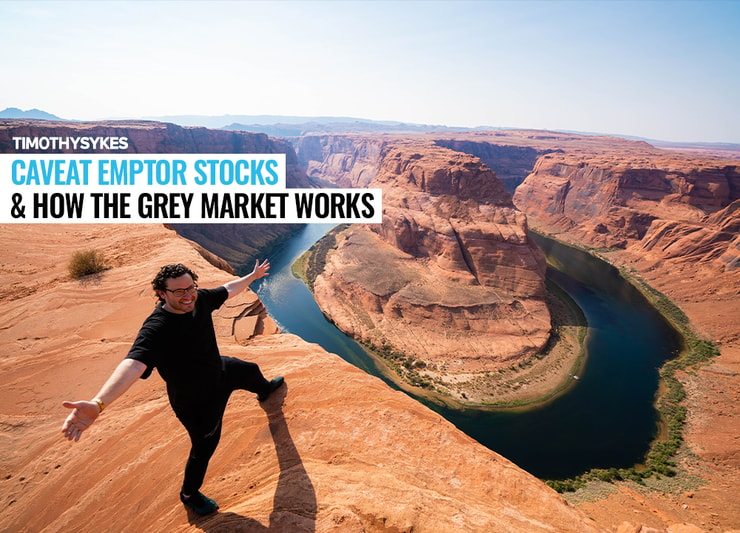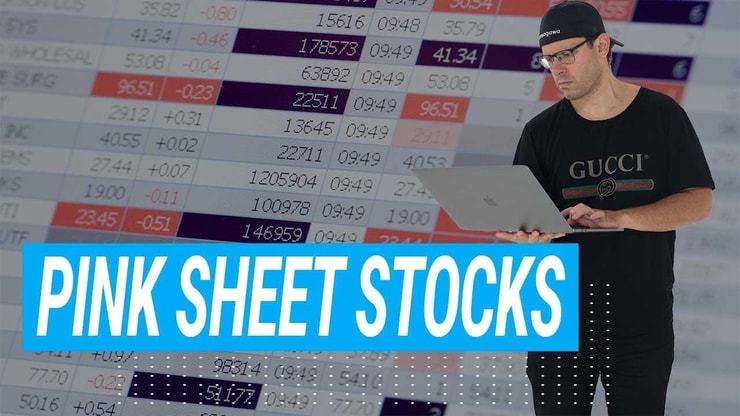Let’s talk about caveat emptor stocks — aka, how sketchy is too sketchy?
A lot of new traders have a hard time understanding risk. Of course, trading is inherently risky. A good trader takes risk into account.
So consider this your day trading PSA: stay away from caveat emptor stocks.
Let’s toss out all the bad things that a skull-and-crossbones mark signals here. Think beyond the fraud, bankruptcy, and shady dealings. If you’ve read my FREE penny stock guide, you already know that I never believe in these stocks anyway.
I don’t care about what OTC stocks claim to be selling. I only care about their volatility and volume.
Caveat emptor stocks have all of the sketchiness of OTC stocks with none of the upside. The lack of information means that it’s impossible to plan for them.
I want you to plan. I want you to prepare. If you’re taking on a trade where you can’t do that, it’s not an excuse…
You should be here because you want to expand your trading education. Read on to learn a crucial cautionary trading tale of caveat emptor stocks…
Table of Contents
- 1 What Is the Grey Market?
- 2 How Does the Grey Market Work?
- 3 Types of Grey Markets
- 4 What Are Grey Market Goods?
- 5 What Are the Causes of the Grey Market?
- 6 Is the Grey Market Legit?
- 7 How to Combat the Grey Market
- 8 What Is a Caveat Emptor Stock?
- 9 Caveat Emptor Designation
- 10 When Does Caveat Emptor Get Removed?
- 11 Conclusion: Should You Trade Grey or Caveat Emptor Stocks?
What Is the Grey Market?
The penny stock market has a wide spectrum of risk.
You have regulated exchanges like the New York Stock Exchange and Nasdaq. This is where Wall Street likes to trade.
Then there are the OTC markets — where OTCQX, OTCQB, and pink sheet stocks trade.
OTC Markets (OTCQX: OTCM) does a bit of due diligence on these first three tiers. But OTC markets include a Wild West tier — yes, it’s even sketchier than the pink sheets.
This is where the ‘prohibited service providers’ and caveat emptor stocks live — the ‘grey sheets’ or OTC grey markets.
These grey markets are for companies that can’t be held to any standard. Grey markets contain stocks that have been delisted, often from other OTC markets.
There’s also another kind of grey market, one that deals in pre-IPO stocks. This grey market is unregulated, but for more intriguing reasons.
These pre-IPO stocks are often traded among insiders. Their sale can help set the price for when the IPO goes public.
How Does the Grey Market Work?
The grey market is a murky world where information and transparency are minimal. Grey market stocks don’t have:
- Market makers promoting the stock
- Analysts who follow and write reports on these stocks
- Information disclosure, such as financial statements
- Risk ratings, like on the pink sheets
If you can’t find grey market stocks on the exchanges or major OTC boards, how do you find them? Not easily. You need to find a broker who deals in grey market penny stocks.
Types of Grey Markets
Like the stocks traded on them, the definition of grey market is hazy. Let’s break this category down a bit more finely…
The ‘Grey Sheets’
When we’re talking about caveat emptor stocks, we’re talking about the bad kind of grey market.
Stocks here have been suspended from trading. This means customers are barred from making transactions. The reasons include fraud, market manipulation, and lack of disclosure.
Grey zone stocks have fallen off the regulatory cliff. They aren’t required to register with financial security regulators. Nor are they required to disclose financial information.
Their lack of registration and disclosure means traders need to be extra careful when trading them — if they even can!
The IPO Grey Market
If you’ve invested in a company before its IPO, then you’ve already traded in the IPO grey market. Before a company’s IPO, it sells shares in the ‘grey market’ to investors.
In the past, large institutional investors could buy pre-IPO shares at a discount. Today, some brokers offer mainstream investors ways to buy IPO shares early.
What Are Grey Market Goods?
Grey market goods trade outside of regulated distribution channels. The manufacturer hasn’t authorized these sales.
Some grey market goods are third-party accessories to mainstream products or commodities. Lost that MacBook charger and don’t want to spend $100 to replace it? You can give the $25 third-party version a whirl … just don’t contact Apple if it catches on fire.
Other times, grey market goods are genuine and high-quality. Maybe the seller bought the product in a country where it’s sold more cheaply. Then they turn around and sell it in the U.S. for less than the suggested retail price.
The Effects of Grey Market Goods
Should traders worry about grey market goods?
Let’s leave the worrying about macroeconomic effects to the analysts. As traders, we really don’t care if a big corporation is losing some of its accessory market share to issuers of grey market goods.
What matters is finding a trading strategy that works for you. That means studying the past and finding your go-to patterns.
You can get a solid start on designing your trading strategy by joining my 30-Day Bootcamp!
Users of these goods are the ones who need to be wary.
Note the focus of this article, ‘caveat emptor’ — buyer beware.
What Are the Causes of the Grey Market?
Grey market causes can range widely. Like many things in the market economy, most come down to money.
Low Price Competition
This is at the root of the retail grey market. People are always on the hunt for the lowest price. They’ll often take it over the guarantees of buying through official channels.
Is the Grey Market Legit?
One thing that applies to all grey markets is a lack of regulation. And although we can complain about regulation, it’s usually there for a reason.
This means you can find worthwhile stocks or products in the grey market. But there’s also a big chance of you falling prey to scams and fraud attempts.
In the grey market, you’re on your own. It’s not just about doing your due diligence by researching available data, it’s also about getting lucky. There are no guarantees that come with grey market sales.
How to Combat the Grey Market
I’ll leave this one to the regulators. Traders and retail buyers only have to worry about the risk to themselves. Your only concerns should be how to manage risk and how to exit the trade if things go wrong.
How do you manage risk? It should be built into your trading plan.
Any kind of trading is a battlefield. But if you’re thinking about trading on the grey market, you’ll be walking through landmines. Focus on your education and think about how you can better navigate the markets.
What Is a Caveat Emptor Stock?
Now we’re getting to it…
The skull and crossbones, the ‘buyer beware.’
You’ve done your homework and listened to my tips. You know you should never trust promoters or the companies behind penny stocks.
Caveat emptor is the label that penny stocks get when they REALLY can’t be trusted.
Caveat emptor stocks have fallen off the regulatory and compliance cliff. These companies have allegedly lied, cheated, and stolen.
A caveat emptor icon can also alert you to future price movements. A caveat emptor designation can cause…
Stock Devaluation
A caveat emptor designation can send a stock tumbling. And if the designation isn’t lifted, the stock’s numbers can remain devalued over a long period.
Remember when Vision Energy Corp (OTCPK: VENG) cratered in January 2023?
Embed Vision Energy Corp (OTCPK: VENG) Stockdio chart
That’s when regulators slapped it with the skull and crossbones … That was for a very blatant promotional campaign that sent the stock up to $26 before crashing it under $1.
During its brief stay in caveat emptor land, it lost its OTCQB designation. That was replaced with ‘CVEM’ in its ticker, shorthand for caveat emptor stock.
Over six small trades, I made over $1,700 in profits on this stock (click the link to see my individual trades).
I did it by staying safe, and never buying into the hype.
Profiting from this kind of volatility is a skill. You need to do the work first. My no-cost “Volatility Survival Guide” is a good place to start prepping for any kind of volatility.
Once regulators place the caveat, it’s a different trading story. Most OTC brokers will stop taking orders for the trade. Liquidity will fall.
When that happens, you’ll need some luck to get out of your position.
Market Decline
When VENG was downgraded, it affected other OTC stocks. If top OTC stocks are in the same sector as the downgraded stock, the entire sector might become bearish.
You’ll likely never trade a caveat emptor stock after it gets the dreaded skull and crossbones. But if you trade any OTC stocks, the threat of CVEM designation always lurks.
Caveat Emptor Designation
What exactly does a stock have to do to deserve this designation? Let’s put it this way — nothing you’d want your kids doing. Especially if they have your credit card.
Regulators usually assess the caveat emptor for one of the following misdeeds…
Stock Promotion
If you know how to trade pumps, the sleazy promoters of the penny stock world can’t hurt you. Follow my advice and NEVER buy into the hype. That’s what most of these businesses are selling.
Fraudulent promoters and shell companies often exploit hot sectors. They snag traders more focused on potential gains than their trading plan. These insiders will be the first ones out as soon as the market for their stock stops being bullish.
What happens to the sad newbies who bought into the hype? Promoters don’t care — as long as they hit their target.
Investigation of Fraud or Other Criminal Activities
Many caveat emptor stock insiders are out-and-out fraudsters. It’s one thing to pump up a company as the next big thing in its industry. But often these promoters are breaking laws.
When a company has been subject to multiple investigations for criminal activities or other issues, you should definitely be wary!
Suspension
A halt in the trading of stocks is sometimes triggered as a result of a news or earnings release. Government regulators place caveat emptor stock suspensions to protect the public and investor interests.
Undisclosed Corporate Activity
Sometimes penny stocks get listed by doing a reverse merger into an existing company. Then the debt and messy balance sheets they inherit get them sent to the penalty box.
Another shady caveat emptor qualifier is doing a stock split without giving investors proper notice.
When Does Caveat Emptor Get Removed?
A caveat emptor stock designation sticks for at least 30 days. If a company wants to return to the OTC markets, it must meet certain compliance requirements.
The big one is filing its financial reports.
Pink sheet stocks can be lax on reporting. But regulators want evidence that companies are acting in good faith.
Occasionally a company makes a mistake and learns its lesson … but I wouldn’t count on that happening. I expect the worst from these companies so I’m never disappointed.
Don’t get caught holding one of these poison pills. Hold and hope is not a strategy. Here’s a video on how to get out of bad trades.
Conclusion: Should You Trade Grey or Caveat Emptor Stocks?
I mean … you’ve been reading this right?
If the type of grey market stock you’re talking about is Elon Musk’s pre-IPO Starlink stock … you probably know more about it than I do.
But if you’re talking about a caveat emptor stock, then you probably don’t know more than I do.
Caveat emptor stocks are warning messages for traders. Smart traders look at them as a bright neon warning that says, ‘Don’t believe in penny stocks.’
The good news is that you trade penny stocks without believing in them. The key is learning to better manage your risk. One smart way to start is to find a great community of traders to share information with. In my Trading Challenge, we have one of the best.
Our Challenge chat room is filled with motivated traders and seasoned veterans like me and my top students. The knowledge we share there is key to learning how to trade penny stocks. You also get access to 7,000 in-depth video lessons, webinars, live, trading, and so much more.
If you want to dance with the sketchiest stocks out there, you need to come in clear-eyed and prepared.
How do you do that? Study, study, study!
Have you been caught holding a caveat emptor stock or survived any close calls? Share your story below, I love to hear from my readers!






Leave a reply